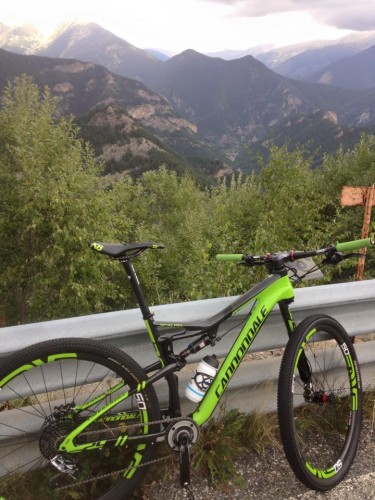Question: In your last column, you gave advice on buying a power meter to use for training on the mountain bike as well as how to set up training zones. Is training with a power meter similar to training with a heart rate monitor? What are your favorite workouts using the power meter for your average cross country racer? Does heart rate still factor into the training?
Answer:
Is Training with a Power Meter Similar to Training with a Heart Rate Monitor?
Training changes significantly on both the micro and macro level once an athlete has switched over from using heart rate as their primary training metric, to power. Power is a direct measure of exercise whereas heart rate is a response to exercise plus many other factors such as fatigue, dehydration, heat, adrenaline, caffeine, altitude and more. These “other” factors make interpreting heart rate data and creating training decisions based on it complicated and rife with guessing. Training with power is clear, precise and has no guessing. You put the power into the pedals and produce the work or you do not. You hit the power target and workout goal or go home to bank recovery. It is an easy decision leading to accurate training.

Many top pros incorporate power training into their training plans. Alex Grant’s team Scalpel with SRM power meter just before the 2015 world championships.
What are Your Favorite Workouts Using the Power Meter for Your Average Cross Country Racer?
The classic workouts that produce fast cross country racing are still my favorite. The difference when training with power is in the accurate pacing and execution of each workout.
10 x 1 min at power L6 with 3 min recovery
6 x 3 mins in power L5 with 3 min recovery
3 x 20 min off-road at cross country race pace with 10 min recovery
Pacing intervals with power vs heart rate:
The biggest difference when pacing intervals, is the lack of time-lag with power that is present with heart rate. Power feedback is immediate. Heart rate feedback has a time-lag. When pacing intervals with power, at the start of each interval, an athlete can dial up immediately to the target power and maintain it for the duration of the interval. When training with heart rate there is a time-lag of 30 – 45 seconds between putting power to the pedals and heart rate rising into the target zone. This time-lag duration leaves you guessing how hard to pedal until heart rate rises and settles into the target zone. Training with heart rate often encourages over-powering the beginning of intervals when trying to get heart rate up quickly into the target zone. Overshooting the target heart rate after starting too quickly leads to under-pacing the end of an interval in order to get the heart rate back down into the target range. The net is a large proportion of the interval duration is spent outside the target range. Training with power takes the guesswork out of pacing intervals and increases the pedaling time on target, increasing training quality. Training with power is like hitting the bullseye every time.
1 minute intervals:
For intervals less than one minute in duration, heart rate does not have time to respond, resulting in both a lack of pacing accuracy and training data to be analyzed. Pacing intervals of less than one minute with power is accurate and produces valuable data to analyze and compare future and past workouts with.
Training with heart rate and fatigue:
Fatigue will depress heart rate. Endurance MTB racers will at times be training while fatigued due to the combination of speed training and long endurance sessions needed to be a successful MTB endurance racer. An athlete can be tricked into training too hard when trying to push a depressed heart rate up into a target training zone. This can lead to over-training. Training with power will increase pacing accuracy producing better results and reducing the risk of over-pacing and over-training.
Track and analyze your season:
One of the most powerful uses of a power meter is to track total training load for both a single workout and over time using the training stress score (TSS) metric generated with power data. TSS takes into account both exercise intensity and duration.
A single ride TSS is like looking at a single tree in a forest. You get a nice picture of that tree but don’t know where it sits in the forest. That is where the Performance Manager Chart (PMC) comes in. The PMC tallies up TSS over time using an exponentially weighted rolling average to give a bird’s eye view of the forest – or your entire season. The PMC can be used retroactively to look at data during times you had personal best performances and during times you thought you should have but didn’t. It can be used for forward planning to target peak form and to perfect peak timing to nail the race of your life.
Does Heart Rate Still Factor Into the Training?
Yes, absolutely, heart rate is still a valuable metric to track. Comparing power and heart rate is useful to gauge the physiological strain of a workout and the depth of fatigue an athlete is carrying. It can also pinpoint dehydration when a rising heart rate is seen with decreasing power during a long ride or race. Resting heart rate and heart rate variability (HRV) are two useful heart rate metrics to track health and training readiness.
Heart rate variability:
Tracking Heart rate variability (HRV) is a valuable use of heart rate data to assess the status of an athlete and their training readiness. More info on HRV tracking here.
Training with power data is a real advantage over heart rate only. Training with both heart rate and power data tracking capabilities is optimal to get a complete picture to work with.
Lynda Wallenfels is a Category 1 certified USA Cycling coach. She coaches mountain bike, cross country and endurance athletes to personal bests and national championships. Lynda has been coaching off-road athletes and racing for 20 years. Contact her through her website for information on mountain bike training plans, coaching and consulting at LWCoaching.com.









